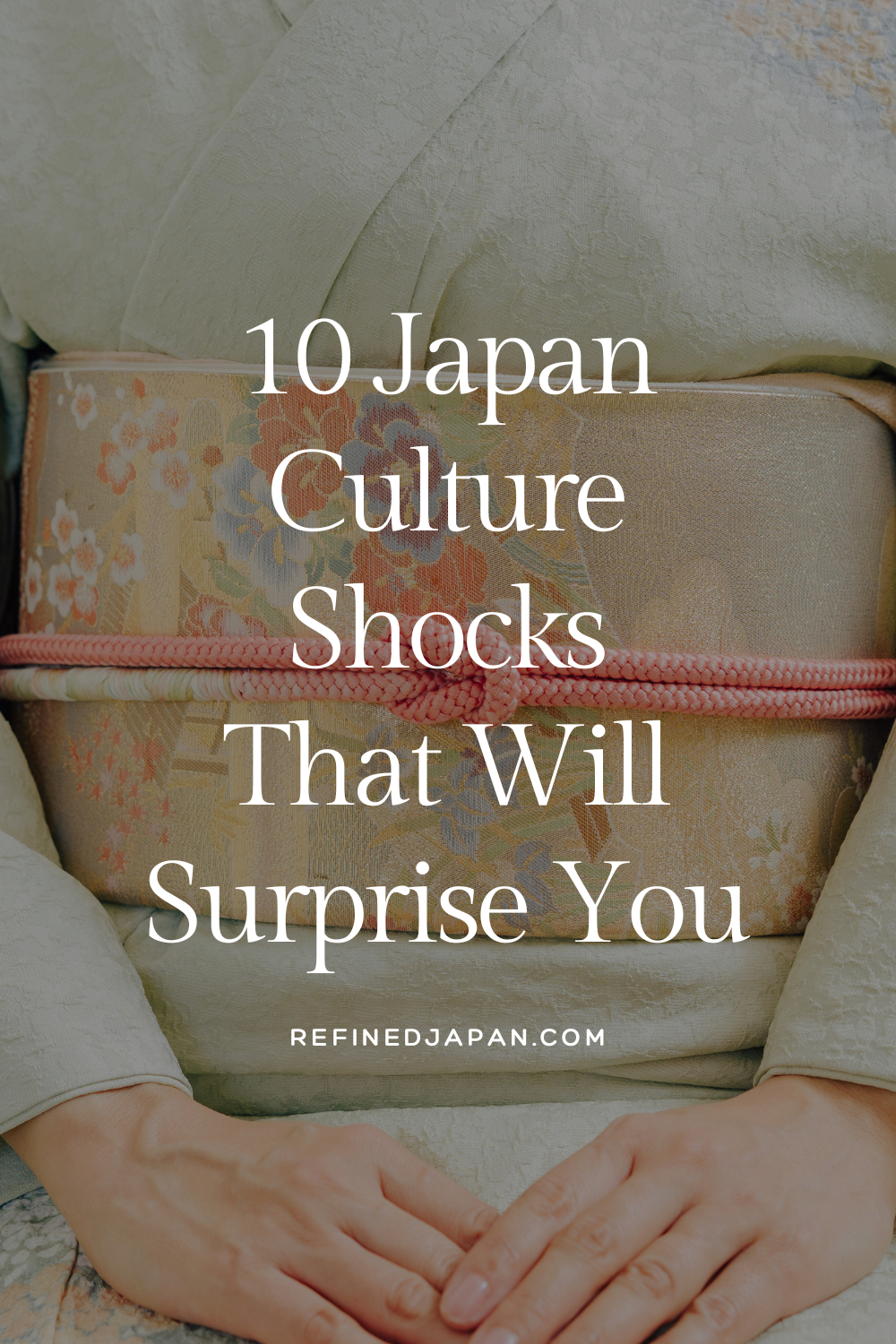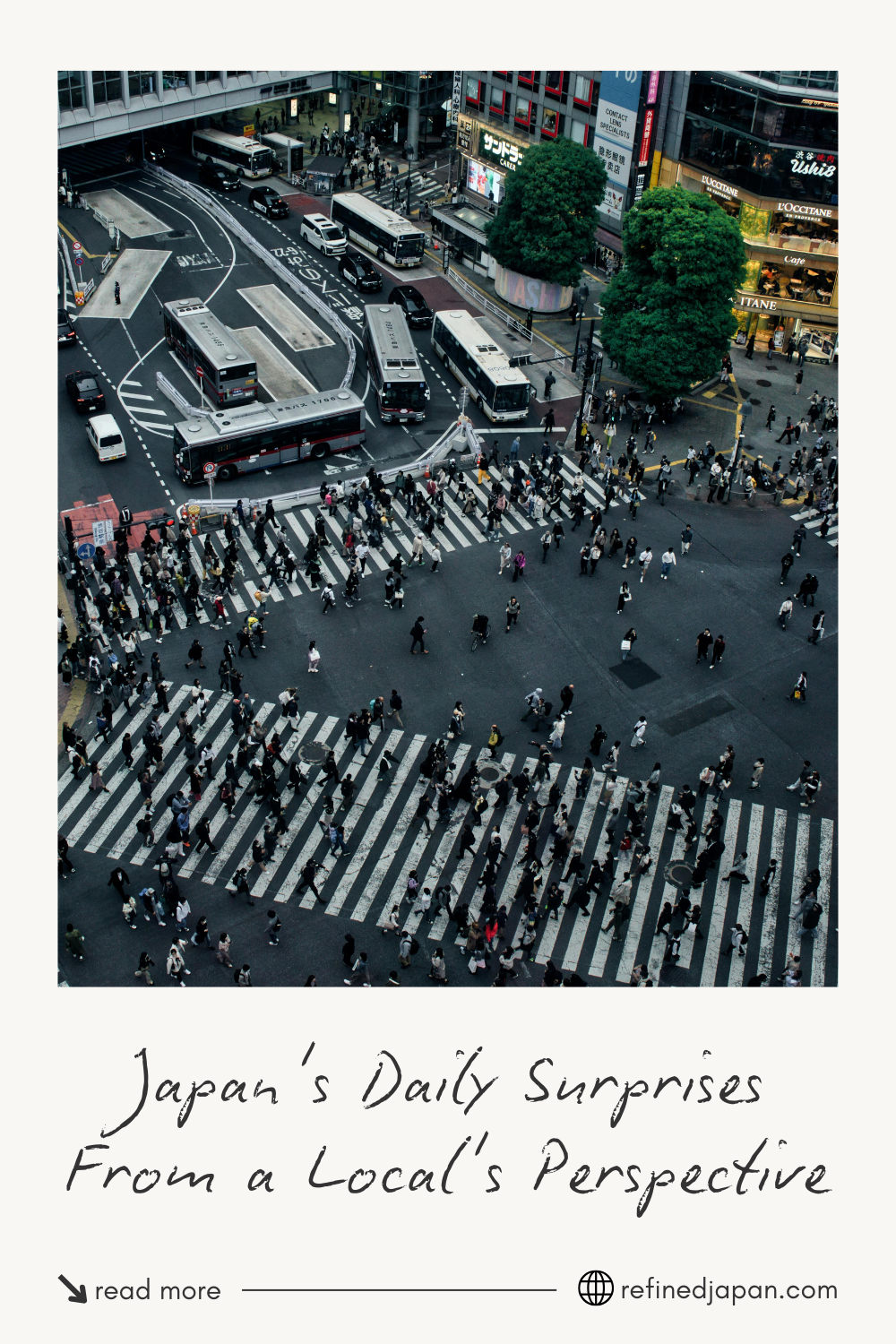“Japan doesn’t shout its differences — but you’ll feel them everywhere.”
I was born and raised in Japan, but after living abroad for more than ten years, I’ve started noticing things that surprise me every time I go back. They’re not the kind of things you’ll find in a guidebook, but those small, almost invisible cultural quirks that everyone ends up experiencing in Japan.
Here are some of my personal “Wait, what?” moments — small shocks that make Japan endlessly fascinating.
🛍 1. The Politeness Overload You Didn’t See Coming
Many people expect Japanese customer service to be polite — but seeing it in action can be almost overwhelming. Sometimes you even start to feel guilty for receiving so much care.
Step into a shop and you’ll be greeted with a cheerful irasshaimase! (“Welcome!”). In department stores, purchases are wrapped with an almost ceremonial level of precision. On rainy days, they’ll slip a protective plastic cover over your shopping bag. Sometimes they’ll add an extra bag, just in case. In Japan, the store’s bag is considered part of the product — and part of the hospitality.
In Tokyo, it’s not unusual for staff to carry your bag outside the store and bow until you’re completely out of sight. It’s a little like being treated as VIP royalty. I grew up thinking this was normal, but now, after years away, I’m always startled by just how far it goes.
This level of formality is more common in big cities like Tokyo. Head into the countryside and you might find service that’s still polite but more casual and chatty.
💴 2. High-Tech Meets… Paper Forms and Phone Calls
The world is going cashless — and Japan is catching up. In major cities, you can use cards or contactless payments at convenience stores, supermarkets, and more. But once you get out into smaller towns or the countryside, you’ll quickly find places that still accept cash only. Some family-run cafés and shops won’t even take credit cards.
But here’s the twist: even in “high-tech” Japan, a lot of processes are surprisingly manual. Need to make a reservation? Sometimes you can’t do it online — you have to call. Want to apply for something? You might be told to print out a form and fill it in by hand. It’s as if digital convenience coexists peacefully with a deep love for paperwork and stamps.
Japan also has a wider range of cashless systems than I was used to in New Zealand: in addition to credit/debit cards and Apple Pay, there are IC cards like Suica, a whole ecosystem of e-money, and QR code payments like PayPay, Rakuten Pay, and d-barai. And yes — at the register, they’ll ask exactly which method you want to use, so be ready with your answer.
🤖 3. Unmanned, Yet Highly Staffed
On my last trip back, I had my first experience with Japan’s “self-checkout” — and it left me confused. I’m used to self-checkouts in New Zealand where you scan and pay without any staff involved. But in my hometown in Kanagawa, I found a very different system: first, you line up at a staffed counter where a clerk scans all your items for you. Then, you take your basket to a nearby self-checkout machine to pay.
I’m sure there are good reasons for this — security, preventing theft, or simply helping older shoppers in a super-aged society. But to me, it felt like peak Japan: a love of efficiency, but never at the expense of human interaction.
🍱 4. Small Plates, Big Ideas
One of the things I look forward to most when going back to Japan is the food. I actually make a list before each trip: ramen here, sushi there, convenience store treats immediately after landing.
But the first shock? Portion sizes! Drinks, meals, even coffee cups — they’re all so much smaller than what I’m used to overseas. When I lived in Japan, I never thought about it. Now, a convenience store bento that once felt like a full lunch suddenly seems… tiny. I remember them being bigger 10 years ago. And coffee? Let’s just say a “medium” in Japan feels more like an espresso shot compared to New Zealand sizes.
Still, if you head to the depachika (department store basement food halls), you’ll find even small portions are beautifully made, with balanced nutrition and gorgeous presentation. In Japan, it’s about quality, balance, and seasonality — not sheer quantity.
🍡 5. Sweet-Savory Harmony
This is one cultural difference I love. In Japan, sweet and salty often live happily together in the same snack or dish. Think of chicken and waffles or Hawaiian pizza — that kind of adventurous pairing is totally normal here.
One of my absolute favourites is Royce’s Potato Chip Chocolate — yes, crispy potato chips covered in silky chocolate. They’re dangerously addictive. You can often find them at airports, and I highly recommend grabbing a box.
Then there’s senbei (rice crackers). In Japan, you can buy sweet-salty versions like zarame senbei (coated in sugar) or “Yuki no Yado” (with a sugary glaze) at almost any supermarket or convenience store. These snacks blur the line between dessert and savoury treat in the best possible way.
🍜 6. Slurp Your Way to Respect
It’s true: in Japan, slurping your noodles is not bad manners — in fact, it can be seen as a sign you’re enjoying the food. This applies to Japanese noodles like ramen, soba, and udon.
That said, I’ll confess: I grew up in Japan and have never been able to slurp properly. And it’s not a free-for-all — if it’s spaghetti or other Western pasta, slurping is considered rude even in Japan. The way etiquette shifts depending on the dish is fascinating once you notice it.
🧠 7. English, But Not Quite
Japan has something called “katakana English” or wasei-eigo — English-sounding words that don’t mean what you think. Some are borrowed from English but have changed meaning entirely.
For example, mansion in Japan means an apartment, not a luxury estate. And consent means an electrical power outlet. Even as a native Japanese speaker, after years of speaking mostly English, I sometimes find myself asking, “Wait — if I say this word in Japan, will they understand me the way I mean?”
If a conversation suddenly doesn’t make sense, check whether the word in question has a different meaning in Japan.
🔤 8. Aesthetic English Overload
Then there’s English that is correct — but used purely for style. Ads, packaging, clothing, tote bags, even J-pop lyrics… Japan loves sprinkling English everywhere. Often, the grammar is off or the meaning is a bit strange, but few people notice because the point is to look stylish, not be accurate.
I stopped buying English-printed T-shirts in Japan after realising how odd some of them sounded. These days, in New Zealand, I see plenty of clothing with equally strange Japanese printed on it — and I admit, I’m tempted to buy them just for fun.
🌸 9. The Kawaii Spectrum
Japan is the land of kawaii — cuteness in every form, for every age. From Hello Kitty to Disney to Studio Ghibli, mascots are everywhere: for towns, companies, sports teams… you name it.
Disney in Japan has a passionate adult fanbase. Growing up, I saw every Disney movie, and it never felt unusual. It was only after moving overseas that I realised — oh, in many countries, Disney is mainly for kids. Even now, a Sanrio character will still make me smile and bring back childhood memories.
🌿 10. Seasons as a Lifestyle
Japan lives in sync with the seasons. Seasonal events like cherry blossom viewing, summer fireworks, and autumn leaf festivals are part of the culture. Shops change their decorations and menus with the season, and seasonal flavours are a big deal.
Spring means sakura, summer brings watermelon, autumn has pumpkin, and winter features yuzu. Limited-edition seasonal ice cream flavours, beers, and snacks are released constantly — making every trip to a convenience store feel like a treasure hunt.
🌏 Conclusion: The Beautiful Weirdness of Everyday Japan
After years abroad, I’ve come to appreciate these quirky moments for what they really are — delightful glimpses into how a culture can be simultaneously ultra-modern and charmingly old-fashioned, efficient yet wonderfully human.
The ultra-polite store clerk who bows until you disappear around the corner? The high-tech vending machine next to a handwritten “cash only” sign? The perfectly tiny bento that somehow leaves you completely satisfied? These aren’t just cultural differences — they’re little daily adventures waiting to surprise you.
Every time I visit Japan now, I find myself collecting these moments like souvenirs. The way a convenience store clerk will carefully arrange your purchases in the bag. The seasonal Kit-Kat flavour you’ve never seen before. The moment you realise you’ve been unconsciously bowing while talking on the phone.
So whether you’re planning your first trip or you’re a long-time Japan enthusiast, keep that sense of curiosity alive. Japan’s magic isn’t in its famous temples or bustling districts (though those are wonderful too) — it’s in these everyday surprises that make you smile, scratch your head, and think, “Only in Japan.”
And honestly? That’s exactly what makes it so addictive to explore.
Bookmark this curated guide on Pinterest



